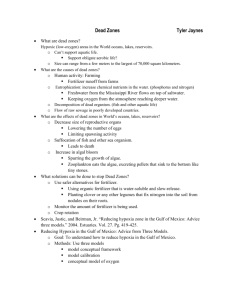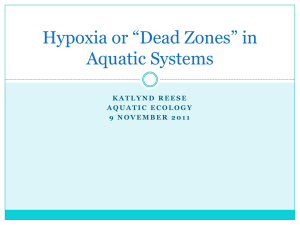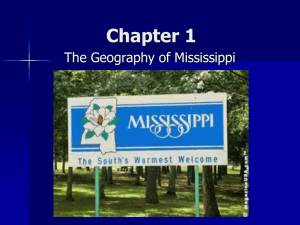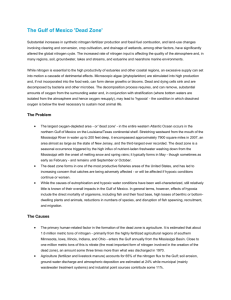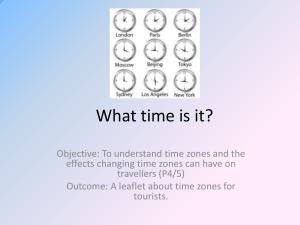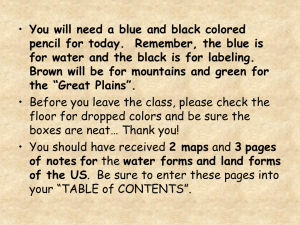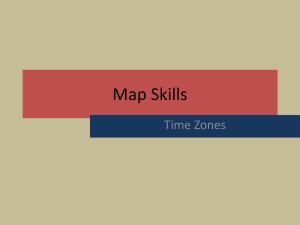(L09)_Oceanic_Dead_Zones
advertisement
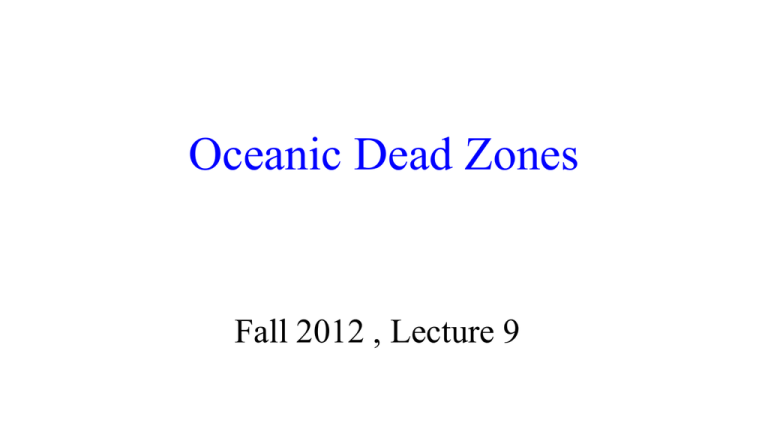
Oceanic Dead Zones Fall 2012 , Lecture 9 Observing the Ocean • Oceans cover about 70% of the earth’s surface • Oceanography, the science of the ocean, has advanced greatly in the last two centuries • The video on the next slide is a production of the Center for Ocean Science Education Excellence (COSEE), and gives a brief view of how oceanography is done today 2 Observing the Ocean 3 “Dead” Zones • Some regions of the ocean may have, or develop, low oxygen zones naturally • One effect is the loss of marine life Mobile life forms, such as fish, leave Immobile forms often die • Habitats that would normally be teeming with life become, essentially, biological deserts, and are often termed “dead zones” 4 Animal Oxygen Requirements • Different organisms have different requirements for oxygen • Fish, because they are mobile, need more oxygen than benthic ogranisms 5 Effects of Hypoxia - 1 • Clams, oysters and other bivalves can survive for hours to days by closing their shells, ceasing to filter water, and going into a dormant state in hopes that normal oxygen conditions will soon improve • However, they too will die if hypoxia lasts long enough 6 Hypoxia Effects the Food Chain • With initial lowering of oxygen concentrations, worms and other animals that burrow deep in the mud will migrate closer to the surface in search of more oxygen • This makes them more vulnerable to fish that are capable of surviving temporarily in low oxygen conditions • Similarly, when fish and mobile invertebrates that rely on hiding from predators along the bottom swim out of a hypoxic area in search of more oxygen, they generally become more vulnerable to larger fish that will eat them. 7 Natural Dead Zones • Hypoxia occurs naturally in many of the world’s marine environments, such as fjords, deep basins, open ocean oxygen minimum zones, and oxygen minimum zones associated with western boundary of many oceans where upwelling occurs • Hypoxic and anoxic (no oxygen) waters have existed throughout geologic time, but their occurrence in shallow coastal and estuarine areas appears to be increasing as a result of human activities 8 Hypoxia and Anoxia • As we have seen, the scientific names for low oxygen conditions are: Hypoxia - low levels of dissolved oxygen as the algae decomposes, defined as dissolved oxygen ≤ 2.0 mg l-1 Anoxia – Near zero oxygen levels, defined as dissolved oxygen <0.2 mg l-1 9 Permanent Hypoxia • Some areas experience essentially constant hypoxia 10 Temporary Hypoxia • In others, hypoxia lasts from hours to days 11 Seasonal Hypoxia • Seasonal hypoxia occurs every year, during the warm months 12 Oxygen Solubility • One important reason for seasonal hypoxia has to do with oxygen solubility • Oxygen is more soluble in cold water, and solubility decreases as temperature increases 13 Satellite Observation • The Sea-viewing Wide Field-of-view Sensor (SeaWiFS) can’t see the bottom of the ocean, but it can see the surface, where sediments from rivers mix with ocean water 14 Satellite Imagery • The images shown here are SeaWiFS observations of the Mississippi River delta, the Yangtze River mouth in China (which is not currently identified as an area with an associated dead zone, but such conditions could develop there in the future), and the Pearl River mouth in China, near Hong Kong 15 Dr. Robert Magnien • Some of the information on the following slides is from a podcast with Dr. Robert Magnien, Director of NOAA's Center for Sponsored Coastal Ocean Research • Link is on the Information page 16 Anthropogenic Dead Zones • There are many physical, chemical, and biological factors that conspire to create dead zones, but nutrient pollution is the primary cause of those created by humans • Excess nutrients that run off land or are piped as wastewater into our rivers and coasts can stimulate an overgrowth of algae, which then sinks and decomposes in the water depletes the supply available to healthy marine life 17 Worldwide Dead Zones 18 Location of U.S. Dead Zones • Primary U.S. Oceanic Dead zones are found: Along the East Coast Along the Gulf of Mexico - the second largest dead zone in the world is located in the northern Gulf of Mexico 19 Northern Gulf of Mexico • The Mississippi River system is the dominant source of freshwater and nutrients to the northern Gulf of Mexico. 20 Mississippi River Flow • The discharge of the Mississippi River system is controlled so that 30% flows seaward through the Atchafalaya River delta and 70% flows through the Mississippi River birdfoot delta • About 53% of the Mississippi River delta discharge flows westward onto the Louisiana shelf 21 Nutrient Pollution • Mississippi River nutrient concentrations and loading to the adjacent continental shelf have greatly changed in the last half of the 20th century • During this time there has been a marked increase in the concentration of nitrogen and phosphorous in the Lower Mississippi River • This increase has been attributed to the increased use of nitrogen and phosphorous fertilizers, nitrogen fixation by leguminous crops, and atmospheric deposition of oxidized nitrogen from the combustion of fossil fuel 22 Nonpoint Sources • Nitrogen and phosphorous occur in four inorganic forms in the river: nitrate (NO3-), nitrite (NO2-), ammonium (NH4+), and orthophosphate (PO4-3) • Many of these nutrients enter the river from non-point sources like runoff, which are much more difficult and complex to control and monitor than point sources of pollution 23 Gulf Dead Zone History • Hypoxia was first documented in the northern Gulf of Mexico off the Louisiana coast in 1972 • Sporadic occurrences were observed in subsequent years • In 1975 and 1976, two cruises were conducted specifically to map a suspected area of low oxygen along the Louisiana coast • These maps indicated small, disjunctive areas of hypoxia • With an increase in oceanographic research in the Gulf of Mexico, more reports of hypoxia emerged 24 Later Research • The first concerted, continuous, and consistent documentation of the temporal and spatial extent of hypoxia on the Louisiana and Texas continental shelf began in 1985 with funding from the National Oceanic and Atmospheric Administration, National Ocean Service 25 CoSEE Dead Zone Video 26 Other Dead Zones in the U.S. • The Great Lakes, particularly Lake Erie • Chesapeake Bay • There is no part of the country, or the world for that matter, that is immune 27 Gulf of Mexico Dead Zone Size • The size of the Gulf of Mexico dead zone actually varies from year to year • The average size, from 1993 to 2001, was about the size of the state of New Jersey or the states of Rhode Island and Connecticut combined 28 Dead Zone Duration and Location • As we saw in Chesapeake Bay, the duration of the dead zone events varies from year to year • The location also varies 29 Typical Dead Zone Scenario • Most dead zones start to form in the spring, most are severe in the summer, and then they break up in the fall • If spring rainfall is high, more nutrients can be washed into coastal waters and that leads to larger dead zones in that particular year 30 Winter Dead Zone Reset • The zone is reset, in a way, each winter, when seawater at the surface of the gulf gets cold and sinks, bringing oxygen-rich water back to the hypoxic bottom • The following summer, the zone reforms, according to Dr. Don Scavia, an aquatic ecologist with the University of Michigan 31 Size Variation • Its size varies from year to year, depending on how much nitrate-rich water is being funneled toward the sea from the Mississippi watershed, Dr. Scavia said • For example, because of 2011Mississippi flooding, last summer’s hypoxic zone was one of the larger sizes recorded – more than two times this summer’s 32 Hurricane Effects • Any oceanic region affected by a hurricane, such as the Gulf of Mexico, hurricane driven mixing can stir up the water sufficiently to reoxygenate the bottom water, even in summer • Usually the dead zone reforms in about one to two weeks 33 Dead Zone Invisibility • From the surface, most dead zones are invisible • Diving into hypoxia zones, or using remote cameras, can sometimes reveal their presence • Factors leading to dead zone formation, such as large algal blooms, are visible 34 Dead Zone Numbers • The number of dead zones has greatly increased since the 1960’s • Over 400 dead zones worldwide have been documents • In the U.S., 166 have been documented 35 Economic Impacts • Exact economic impacts are largely unknown • In 2009, the Gulf of Mexico fisheries amounted to about $2.8 billion • How much was lost to the dead zone has yet to be quantified 36 Research Efforts • The Center for Sponsored Coastal Ocean Research in the National Ocean Service spent $27 million over 15 years on hypoxia research • That produced a Management Action Plan, first issued in 2001 and revised in 2008 • They issue seasonal predictions of the dead zones in the Gulf of Mexico and Chesapeake Bay 37 Recent Episodes • Chris Paschenko reported in The Galveston Daily News on August 13, 2012, “Low oxygen levels are believed to have killed possibly hundreds of thousands of Gulf menhaden fish found littering beaches and shorelines from Matagorda to Galveston, officials said Sunday.” (August12) 38 Why Menhaden? • Gulf menhaden, also known as shad, are more susceptible to fish killings than other species • Steven Mitchell, a biologist with the Texas Parks and Wildlife Department, said “Menhaden swim in the thousands of fish in schools, and when they get into trouble, they just can’t get out of it. I suspect the schools were swimming in a dead zone offshore, but we haven’t confirmed that.” 39 Red Tide Responsible • Low to moderate concentrations of red tide, an algal bloom known as Karelia brevis, also were believed to have caused fish kills in Galveston Bay • The presence of the algae prompted the Texas Department of State Health Services on Monday to close what little oyster harvesting was ongoing by public lease holders in Galveston Bay, department spokesman Chris Van Deusen said • Oysters are harvested commercially in Texas only from November to April 40 Galveston Fish Kill • Stan Lewis of Dallas rakes dead fish away from his family’s tent at Bermuda Beach in Galveston on Sunday • Officials said a red tide could be responsible for the fish kill • Photo by Jennifer Reynolds 41 Dead Zone and Drought • NOAA-supported scientists have found the size of the 2012 Gulf of Mexico oxygen-free ‘dead zone’ to be the fourth smallest since mapping of the annual hypoxic, or oxygen-free area began in 1985 • Measuring approximately 2,889 square miles, the 2012 area is slightly larger than Delaware 42 Dead Zone Variation • Scientists supported by the National Oceanic and Atmospheric Administration (NOAA) have been monitoring the size of the Gulf of Mexico dead zone since 1985 • From 1985 to 1992, the extent of the summer dead zone averaged about 3089 to 3475 square miles • From 1993 to 1997, the size of the dead zone had grown to 6178 to 6950 square miles • The largest dead zone ever recorded occurred in 2002 and measured 8400 square miles 43 Gulf of Mexico, 1985-2011 • In 2012, it was 2889 mi2 44 Control of Fertilizer Input • The small 2012 dead zone suggests that a reduction of nitrate input into the Gulf of Mexico would have an immediate impact • In addition to controlling the agricultural and home inputs of fertilizer, is there another way of reducing dead zones? 45 Natural Fertilizer Buffers • Dr. Scavia has two suggestions: Building wetlands around the rivers would encourage the natural denitrification that occurs in such ecosystems Buffering rivers with grasses to absorb the nitrates would also help 46 Environmental Activism • Green groups have been trying to persuade the Environmental Protection Agency (EPA) to set a limit for the amount of nitrogen and phosphorus allowed in the states whose rivers feed the Mississippi • In March, 2012 members of the Mississippi River Collaborative, an environmental group, filed a lawsuit designed to force all those involved to think about ways to solve the problem 47 Environmental Pushback • The Federal Water Quality Coalition, a group composed of industrial and metropolitan water users, has launched its own lawsuit in opposition to the first • It argues that the federal government should play no role in setting limits, and furthermore that the very idea of limits is too simplistic 48 State Action • Wisconsin is one of the few states to introduce, in 2010, statewide numerical limits for phosphorus • Joe Parisi, who runs Dane County, says these have spurred the county into working on new measures with the Madison metropolitan sewerage district 49 State Ideas • Wisconsin has suggested two ideas One is an innovative community biodigester that generates power from cattle manure Another idea is a low-tech effort to extract phosphorus by using crops which are then harvested 50 Upstream Problems • The effects of nutrient pollution are increasingly apparent throughout the Mississippi River basin • Environmentalists say that half the streams in the upper Mississippi have too much nitrogen and a quarter have too much phosphorus, according to an article in The Economist 51 Effects Upstream from the Gulf • Nutrient enrichment damages aquatic life along the rivers and streams in the Mississippi watershed, and degrades drinking water quality • Blooms of toxic algae have closed beaches, made people ill and killed fish and pets along various rivers • Nasty green lakes have also damaged tourism, property values and fisheries 52 Dead Zones and Climate Change • Dr. Lou Codispoti, University of Maryland Center for Environmental Science oceanographer, has produced research showing that hypoxic zones in the ocean can contribute to the release of nitrous oxide (N2O), a powerful GHG 53 N2O Production • Dr. Codispoti found that the yield of N2O increases twenty-fold between water saturated with oxygen and water at 1% oxygen saturation • He states that net N2O production in the open ocean is about 6 Terragrams of N per year, and half is from hypoxic and suboxic waters • Estuaries produce an additional amount, about half that of the ocean 54 Shallow Waters • He says, “N2O production rates should be particularly high in shallow suboxic and hypoxic waters, because respiration and biological turnover rates are higher near the sunlit waters where phytoplankton produce the fuel for respiration” 55 Enhanced GHG • Thus, increasing inputs of nitrogen fertilizers into shallow estuarine or coastal shelf waters will contribute substantially to enhancing a powerful GHG 56 Other Sites Around the world • Hypoxia is not limited to the United States • We will look at two other cases Black Sea Baltic Sea 57 Black Sea • This large, inland sea has also been affected by humans for centuries • Nutrients entering the system from rivers like the Danube began to increase sharply in the 1960s, causing an increasing dead zone on the northwestern part of the Black Sea 58 Black Sea Improvement • This anthropogenic dead zone was an addition to the permanent dead zone that exists in the deepest parts of the Black Sea • After the Soviet Union collapsed in 1989 a rapid slowdown of intensive farming and the large-scale raising of livestock in the Danube watershed caused great reductions in the amount of nutrients entering the northern Black Sea 59 Northwestern Black Sea • Bt the mid-1990’s, the dead zone of the Northwestern Black Sea all but disappeared • This gives hope that large reductions in nutrient load will indeed reduce the frequency and extent of dead zones • High nutrient loads cause major phytoplankton blooms on the Black Sea 60 Nutrient Loading • The diagram shows the effect of nutrient loading 61 Baltic Sea • This northern European body of water is a salty, deep system that has been affected by humans for centuries • Following World War II, increasing fertilizer use and a growing population led to high inputs of nutrients to the system from rivers like the Oder and the Vistula. 62 Baltic Sea Decline • As happens in many marine systems, this increased nutrient load caused algae blooms which eventually caused low oxygen conditions • Efforts to decrease nutrient loads to the Baltic were successful in minimizing the size of the dead zone in the mid-1990s • Unfortunately, climatic conditions have caused dead zone area to increase again in recent years 63 Baltic Sea Hypoxia Area • Decreases in nutrient loading helped 64 Baltic Sea Stratification • The Baltic Sea water is stratified - density differences of changing water temperature creates a seasonal thermocline, a layer where temperature rapidly changes • The strongest thermocline exists in the summer when warmed surface water separates from colder bottom water • Summer thermocline usually exists in approximately water depth of 10-20 meters • In warm summer weather the surface temperature can rise up to 20-22 °C, while the bottom water under the thermocline stays at 35 °C 65 Baltic Thermal Conditions • The summer stratification is evident 66 Climate Change Effect • The thermal stratification in summer leads to an anoxic zone in deep water • As climate change heats summer waters, the stratification begins earlier and lasts longer 67 Baltic Ice Cover • Annual size of the Baltic Sea ice cover since the 1700s based on various types of observations • The annual variation is large, but the variations are considerably smaller when illustrated as 30-year mean values (red curve) • The green line shows the average size of the ice for the entire period and the circle marks a breakpoint where the climate changed and the Little Ice Age ended 68 Deepwater Horizon • Deepwater Horizon was an ultra-deepwater, dynamically positioned, semi-submersible offshore oil drilling rig • In September 2009, the rig drilled the deepest oil well in history at a vertical depth of 35,050 feet (10,683 m) and measured depth of 35,055 feet (10,685 m) approximately 250 miles southeast of Houston, in 4,132 feet (1,259 m) of water 69 Deepwater Horizon Explosion • On April 20, 2010, while drilling at the Macondo Prospect, an explosion on the rig caused by a blowout killed 11 crewmen and ignited a fireball visible from 35 miles away • The resulting fire could not be extinguished and, on April 22, 2010, Deepwater Horizon sank, leaving the well gushing at the seabed and causing the largest offshore oil spill in U.S. history 70 Deep Horizon Fire Video 71 Capping the Well • The gushing wellhead was capped, after it had released about 4.9 million barrels (780,000 m3) of crude oil, on July 15, 2010 • On September 19, 2010, the relief well process was successfully completed, and the federal government declared the well “effectively dead” 72 Persistent Problems • In August 2011, oil and oil sheen covering several square miles of water were reported surfacing not far from BP’s Macondo well, but the oil was too dispersed to recover • Scientific analysis confirmed the oil is a chemical match for Macondo 252 • The Coast Guard said the oil In March 2012, a "persistent oil seep"near the Macondo 252 well was reported 73 Early Scientific Observation • “There’s a shocking amount of oil in the deep water, relative to what you see in the surface water,” said Samantha Joye, of the Institute of Undersea Research and Technology at the University of Georgia who is involved in one of the first scientific missions to gather details about what is happening in the gulf. “There’s a tremendous amount of oil in multiple layers, three or four or five layers deep in the water column.” (Quoted from article by Justin Gillis, N.Y. Times, May 15, 2010) 74 Methane Emission • One early concern about the oil spill was the amount of methane associated with the petroleum • John Kessler, a Texas A&M University oceanographer, said that the oil emanating from the seafloor contains about 40 percent methane, compared with about 5 percent found in typical oil deposits 75 Dissolved Methane • A BP spokesman said the company was burning about 30 million cubic feet (850,000 cubic meters) of natural gas daily from the source of the leak • In early June, a research team led by Samantha Joye investigated a 15-mile-long plume drifting southwest from the leak site • The team reported methane concentrations up to 10,000 times higher than normal, and oxygen levels depleted by 40 percent or more 76 Methane Dead Zone • Joye’s research team found that some parts of the plume had oxygen concentrations just shy of the level that tips ocean waters into the category of "dead zone" — a region uninhabitable to fish, crabs, shrimp and other marine creatures • John Kessler’s research team found similar results - he said he has already found oxygen depletions of between 2 percent and 30 percent in waters 1,000 feet (300 meters) deep. 77 Oxygen Depletion • Small microbes that live in the sea have been feeding on the oil and natural gas in the water and are consuming larger quantities of oxygen, which they need to digest food • As they draw more oxygen from the water, two problems result When oxygen levels drop low enough, the breakdown of oil grinds to a halt As oxygen is depleted in the water, most life can't be sustained 78 Dispersants • British Petroleum treated the spill with very large quantities of dispersants • Dispersants are chemicals designed to attach to oil molecules and to water molecules, making the petroleum much more soluble in seawater, and helping to break the spill into many tiny droplets 79 Invisible? • Small droplets are easier for microbes to attach and break down the petroleum • Of course, breaking up the petroleum and getting it into the deep water column make it much less visible at the surface….. 80 Dispersant Toxicity • Many dispersants are quite toxic, and biologists fear they could cause increased marine mortality, leading to chemical dead zones 81 Dispersant and Petroleum Quantities • BP used 1.8 million gallons of Corexit dispersant • It is believed that a lot of the estimated 200 million or more gallons of oil that spewed out of the blown well remains under the surface of the Gulf in plumes of tiny toxic droplets 82 Dispersant in Crabs • Scientists have found signs of an oil-and-dispersant mix under the shells of tiny blue crab larvae in the Gulf of Mexico • Harriet Perry, a biologist with the University of Southern Mississippi's Gulf Coast Research Laboratory, said marine biologists started finding orange blobs under the translucent shells of crab larvae in May, and have continued to find them "in almost all" of the larvae they collect, all the way from Grand Isle, Louisiana, to Pensacola, Fla. -- more than 300 miles of coastline 83 Dispersants as Delivery Systems? • "Corexit is in the water column, just as we thought, and it is entering the bodies of animals. And it's probably having a lethal impact there," said Susan Shaw, director of the Marine Environmental Research Institute. The dispersant, she said, is like " a delivery system" for the oil. • "The properties that facilitate the movement of dispersants through oil also make it easier for them to move through cell walls, skin barriers, and membranes that protect vital organs, underlying layers of skin, the surfaces of eyes, mouths, and other structures." 84 Waiting for Answers • This is a clear indication that the unprecedented use of dispersants in the BP oil spill has broken up the oil into toxic droplets so tiny that they can easily enter the foodchain • What the longer term effects of Corexit and petroleum on life in the Gulf will be await years of on-going research 85 ROV’s • On October 18, 2012, remote operated vehicles (ROV’s) deployed from the offshore construction vessel Skandi Neptune collected oil samples from the underwater site of the Deepwater Horizon incident to determine the source of a surface sheen discovered last month 86 Oil Samples • Samples were taken after the ROV video showed apparent oil globules leaking from the containment dome at approximately 15 globules per minute, which is estimated to be less than 100 gallons per day • In 2010, the 40‐foot‐tall containment dome was used as part of an attempt to capture oil and allow it to flow through a pipe to a barge on the surface 87 Containment Dome • This technique was not successful and the equipment was moved away from the well head and riser pipe, and set in its current position approximately 500 meters from the original Macondo well head • It is entirely separate from the well head and any riser piping 88 Recent Work • The Federal On-Scene Coordinator for the Deepwater Horizon oil spill in New Orleans authorized BP to proceed with a plan to cap and plug the containment dome on 10-25-12 • The technique was unsuccessful and the equipment was moved away from the well head and riser and set in its current position approximately 500 meters from the original Macando well head 89 BP Deep Horizon 2nd Anniversary • CBS News report - April 20, 2012 90
